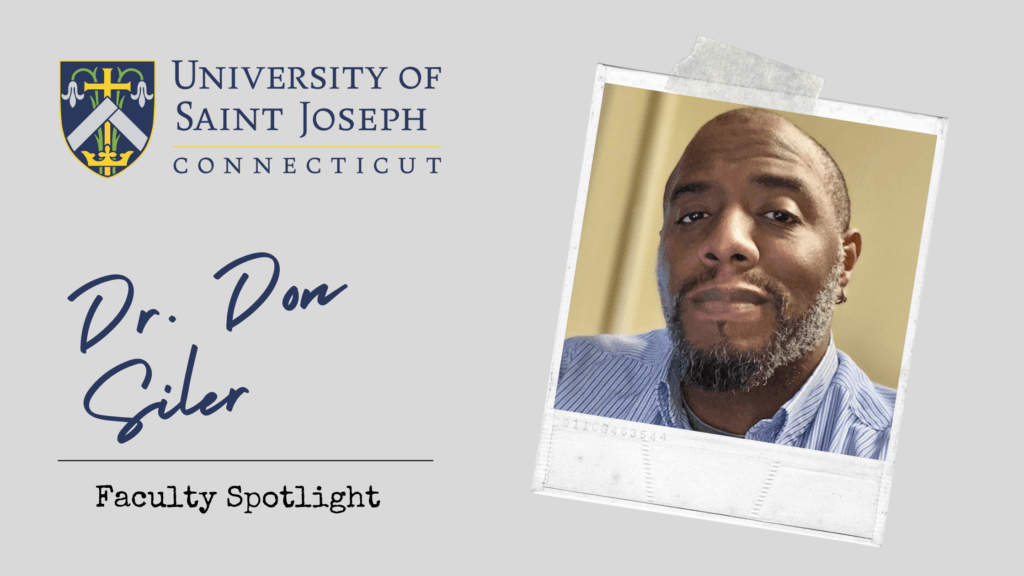Meet Dr. Don Siler, a USJ Associate Professor of M.A. Arts Integration and M.A. Instructional Design Programs, who creates a welcoming environment for all.
What programs do you teach at University of Saint Joseph? What drew you to this field of study? What keeps you excited about it?
I have taught across several of our programs, but I mainly teach M.A. Arts Integration, M.A. Instructional Technology, and M.A. Curriculum & Instruction courses. These courses focus on building students’ and teachers’ pedagogical, theoretical, and curricular “toolboxes” so that they are better equipped to address the needs of all students.
In the Arts Integration courses, students examine how the arts, cognitive sciences, and classroom instruction can come together to create effective and welcoming multimodal learning environments. Likewise, Instructional Technology takes students on a research-based and engaging journey through the practical and ethical considerations of using technology in the classroom.
I also try to ensure that my students are reminded of the importance in understanding their students and using those connections to make learning more accessible and engaging. I came to this work after my own frustrating experiences as a K-12 student; those experiences led me to become a teacher and, later, a professor.
How will your programs better prepare/equip educators for the current climate they are facing?
Our approach to instruction and learning has become even more critical during the COVID-19 pandemic. Teachers have been asked to modify their entire pedagogies as schools moved between remote, hybrid, and fully in-person teaching. We have adjusted our program delivery to address student safety and preferences while maintaining high standards for content delivery.
Our programs now include a mix of in-person, online, and hybrid courses. This lets our students see what each model can entail while also hopefully giving them more of the flexibility that their jobs often require of them. Our programs also help students hone their own technological and curricular skills in ways that can have an immediate impact on their work.
What attracted you to teach at University of Saint Joseph? What sets them apart?
I came to University of Saint Joseph (USJ) because of the school’s commitment to providing a robust, quality, humanistic, and constructivist education. USJ focuses on creating thoughtful, service-oriented practitioners. In my time at the university, I have found that the students came here for many of the same reasons: they express the desire for the types of relationships they can build at a small, dedicated, liberal arts school.
The school has a reputation as a place where students can feel “at home” while getting a good education. Although there is always room for more growth in terms of meeting student needs, USJ has been able to maintain its student-centered approach. This is especially noticeable in our off-campus programs, where in-service teachers have been exposed to new and innovative ways to enhance their already substantial expertise and skills.
What is your professional background as an educator?
I began that journey as a disillusioned high school dropout who went to college to fulfill a promise. I decided to study education to help prevent other black, male, and marginalized students from having the same experiences I had. That motivation crystalized into a teaching philosophy centered on creating engaging and welcoming learning environments for all.
When I became a high school art teacher, I kept that focus and have further operationalized, modified, and modeled it through 14 years of combined graduate studies and teaching in higher education. Teaching in the Arts integration and Instructional Technology programs gives me the opportunity to apply my background in educational technology and art education. Each program takes a creative approach to exploring and applying concepts.
What would you tell prospective students considering your programs about yourself? What’s something that students and colleagues should know about you?
I want our current and future students to know that my motivations and interest in what’s best for all students is not unique at USJ. We have worked hard to ensure that our Department of Education is filled with thoughtful and caring professionals who are also experts in their areas.
We understand that teaching is a field where skill and humanism go hand-in-hand, and we work hard to model that. We work to be flexible while maintaining high standards for ourselves and our students.
Any student or teacher considering joining our Arts Integration or Instructional Technology cohorts should know that you don’t need to already be well-versed in these areas. Your expertise in your subjects and your passion for learning are all you need.
What advice do you have for students interested in pursuing their arts integration or instructional technology degrees? How can people stand out in these fields?
We built these programs to move from broad theoretical introductions to hands-on practice, to finally culminating capstones wherein you can pursue rigorous, individualized research or unit planning intended to showcase and apply your learning.
We know that you all come in with different skills, interests, motivations, and perspectives. Our flexible courses will allow you to craft your own experiences to become an even more capable educator.
We are also a department with varied approaches and perspectives. This means students will be able to have well-rounded experiences throughout their programs. And perhaps most importantly, we make every effort to ensure that what our students learn and explore will be immediately applicable in their current and future classrooms. Many courses have assignments that require classroom implementation and data analysis that should and can fit into existing curricular timeframes. The resulting outcomes show learning for the course and help teachers build their existing capacities in real-time.
Is there anything else you would like to share?
Our students are often asked to become building experts and lead professional developments on what they’ve learned. Many have gone on to earn other master’s degrees in USJ off-campus programs, and several have earned doctorates and eventually started teaching for us. There is no ceiling.


